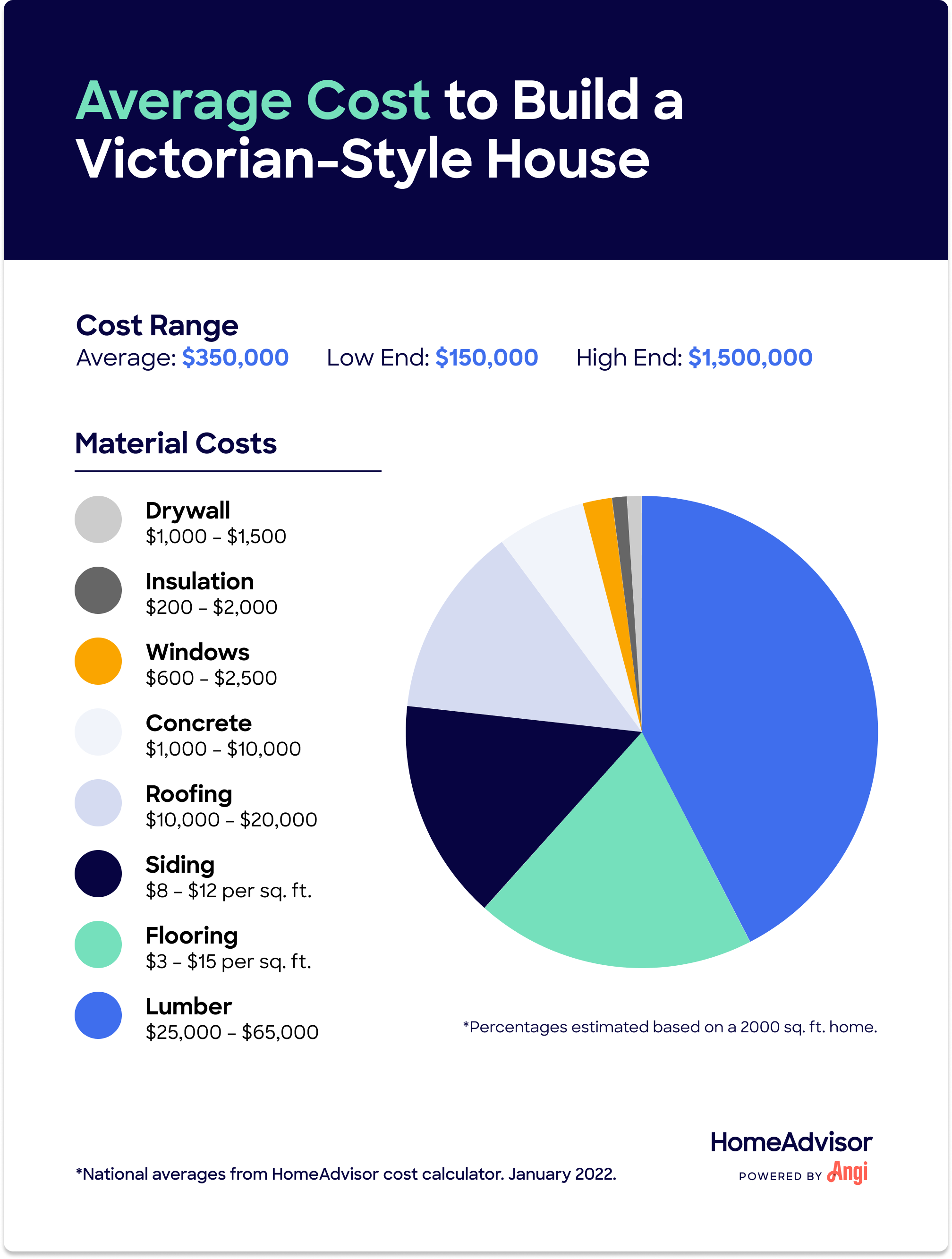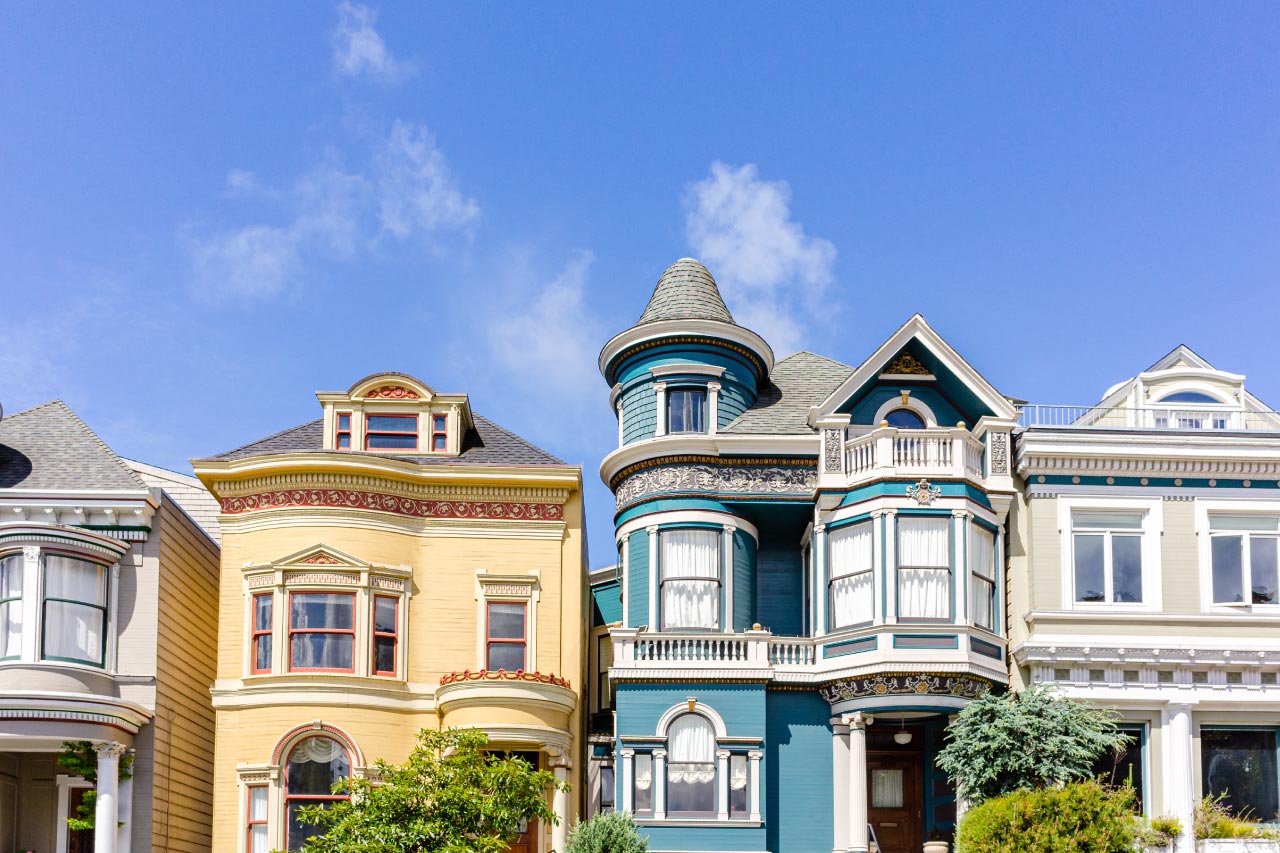How Much Does It Cost to Build a Victorian-Style House?
Typical Range:
$150,000 - $1,500,000
Typical Range:
$150,000 - $1,500,000
Cost data is based on research by HomeAdvisor.
Updated April 16, 2024
Written by HomeAdvisor.Victorian-style builds require intricate designs and more skilled labor, which increases installation and build costs.
The average cost to build a Victorian-style house varies with design intricacy, ranging from $50,000 to $175,000 for interior finishing alone.
Key project cost factors include materials used, general contractor rates, house plan and designer fees, and intricacy of Victorian design elements.
Key materials for Victorian-style homes include shingle siding, interior cornice, decorative trims, and hardwood flooring.
Project warning signs include higher material costs, intricate design details, and potentially more expensive exterior finishing.
Building a Victorian-style house offers benefits like customization, intricate design features, and avoidance of maintenance issues common in older properties.
Highlights were summarized from this existing cost guide text using automation technology and were thoroughly reviewed for accuracy by HomeAdvisor Editor Ryan Noonan.
In the U.S., it costs, on average, $350,000 to build a Victorian-style house. Typically, most homeowners spend between $250,000 and $600,000. The average cost per square foot to build a Victorian-style home is $100 to $200. For homes with high levels of intricate Victorian architecture in their plans, the price can reach as high as $500 per square foot. Prices also vary considerably depending on the home size, location and quality of finish.
| Average | $350,000 |
| Low End | $150,000 |
| High End | $1,500,000 |
Set aside around 50% of your total budget for materials. Because of the intricacy of this style of architecture, material costs are higher than a standard box-build modern home. The final amount spent depends on how many Victorian elements you incorporate into your design, the quality of the materials and where you source them. Below are some of the key materials you should budget for.
| Material | Average Costs |
|---|---|
| Lumber | $25,000 – $65,000 |
| Concrete | $1,000 – $10,000 |
| Drywall | $0.50 – $0.75 per square foot |
| Insulation | $0.10 – $1 per square foot |
| Roofing * (gabled roofs are common and tend to be less expensive than flatter hip roofs, but complex, double-sloping mansard roofs are more expensive) | $10,000 – $20,000 |
| Flooring * (tiles and hardwood flooring are common) | $3 – $15 per square foot |
| Siding * (intricate shingle or shake siding is common and more expensive than traditional lap siding) | $8 – $12 per square foot |
| Windows * (large bay, dormer, sash and stained glass windows are common) | $600 – $2,500 |
*indicates Victorian-style design elements’ mean costs typically run higher than the average new build’s
General contractor rates are typically 10% to 25% of the total project cost; savvy home builders hire a general contractor to oversee the project. They manage and pay laborers and subcontractors, source materials and support permit applications, among other tasks.
Victorian-style builds are often custom designs with intricate details, and pros require a high level of skill and more hours of labor. Consequently, installation and build costs are typically higher than a typical new build home.
Examples of Victorian-style build elements that require more skill and time include shingle siding rather than lap siding, interior cornice, turret or tower construction and decorative trims.
From planning to interior finishings, there are costs associated with each phase of the construction project. Even if you hire a local general contractor, it’s helpful to understand what each part of the project is likely to cost, so you can better analyze and understand the written agreement they provide you.
Budget for between $2,000 and $8,000. Purchasing a pre-made blueprint is cost-effective, but you may want to customize it or opt to have an architect make a fully bespoke plan. Below are some indicative fees you could incur in the planning phase. For Victorian-style homes, prices may be on the higher end because of the intricate design details.
Architect costs: $125–$250 per hour
Structural engineer costs: $100–$200 per hour
Draftsperson costs: $50–$130 per hour
Interior designer rates: $50–$200 per hour
Landscape architect costs: $70–$150 per hour
Even before construction begins, costs mount up. Some of the key pre-construction elements to consider include:
Land purchase: The average housing land costs range from $50,000 to $100,000, but prices vary widely, depending on the size of the space and its location.
Prepping land: If you don't purchase land on a housing development, you may have to pay to clear it for construction. Land excavation and grading coststypically run between $1,500 and $5,000. If there’s an existing building on the site, the cost to demolish a house falls between $3,000 and $25,000. Thisdepends on the size, location and whether any toxins, such as asbestos, are present.
Building permits: You could spend between $1,200 and $2,000 on building permit costs for your construction project. Costs and requirements vary depending on the local authority regulations.
The cost to install the foundation for a new house runs between $18,000 and $30,000 (including excavating). One advantage of a Victorian-style home is that they’re usually two-story buildings, and these cost less to build the foundation than a bungalow with more floor space.
Framing costs for the average 2,000-square foot single-story home run between $14,000 and $32,000, with an additional $4,000 to $16,000 for sheathing and wrap. Given most Victorian-style homes aren’t bungalows, it’s worth noting that the second story of a two-story home generally runs about $3 per square foot more than the first floor.
You’ll need to factor in around $30,000 to $75,000 for the materials and installation of the major systems like plumbing, electrics and HVAC.
Budget at least $50,000 to $60,000 for exterior finishing work, but how much you spend on materials and installation depends on the design’s quality and intricacy. For example, many Victorian-style houses feature mansard roofs. These steep roofs have two slopes on every side and the cost to install them is higher than average. The cost to paint the house exterior and install large bay windows are other examples of how exterior finishing costs may be higher than average.
The average cost for interior finishing is between $50,000 and $175,000. Victorian-style houses with a high level of ornate detail are more likely to be on the higher side of these estimates. Fireplaces in many rooms, chandelier lighting and hardwood flooring are some expenses you might not have in a simpler home style.
How much you spend on building a Victorian-style house can vary dramatically. Below are some of the key factors which affect your budget.
An average U.S. house is just over 2,000 square feet. However, Victorian-style house plans vary in size. The size you opt for depends on the lot size, your family size and the space’s design.
Desirable locations in or near major cities inevitably cost more. The price for the land, contractors and even materials can be more than in rural areas.
There are various sub-styles of Victorian home architecture. They all have their own distinct design elements that make them identifiable, but these intricacies add to your overall budget.
The famed Queen Anne style, for example, features heavy ornamentation, rounded towers and huge windows. Gothic Revival style homes often feature pointed, decorative windows, pinnacles and shaped parapets.
You don’t have to opt for the most expensive materials to achieve a high-end, durable finish. For example, vinyl shingle siding is considerably less expensive than the wood equivalent, but you can still achieve an elegant finish with this material.
If you want to go all-out Victorian in your design, this could add more to your costs than if you choose to add just certain elements to your home design. Some popular Victorian design elements that will likely add to your construction costs include:
Towers and turrets
Decorative trims
Impressive staircases
Fireplaces in multiple rooms
Wraparound porches
Exterior house painting
Elaborate cornices
You can save 30% to 50% on total project costs by taking on the entire build yourself. Choosing to act as a general contractor could save you 10% to 20% on the total project costs, but you need to invest a lot of time researching materials, contractors, permits, and building codes. Ultimately, you need a high level of construction and management skills.
Unless you have extensive skills and experience, taking on an entire house build yourself is not a good idea—regardless of how much money you think you can save. Navigating the permit process, relevant building codes and the complexities of a major constructional project like this is challenging. DIYers often go massively over budget and timelines and may even need to hire pros to remedy costly mistakes.
For Victorian-style houses with intricate woodwork, windows and other ornate finishings, it’s even more of a challenge for someone without skills in these areas.
Taking on some of the interior or exterior finishing work rather than structural elements offers an opportunity to cut costs without it being too difficult. This might include things like painting, flooring or tiling.
Hiring the right general contractor keeps you on time, on budget, and the quality of the work will be high. Shortlist a few contractors to get quotes from. They should have appropriate licenses, insurances, and experience—always follow up on references, too.
Once you’ve made a decision, read the written contract carefully before signing. It should clearly outline the contractor's responsibilities, the scope of the project and costs and timelines.
Although any reputable general contractor can support the project, looking for those with experience in adding Victorian-style features offers additional peace of mind.
Generally, purchasing a Victorian-era property costs less than building a new one of a similar size in the same location. You also get the original features and character that come with this type of historic property. However, building a new home means you can customize the design and layout. You’ll also avoid potentially costly maintenance that can arise in older properties from things like dampness, defective masonry, poor insulation and plumbing and electrical problems.

